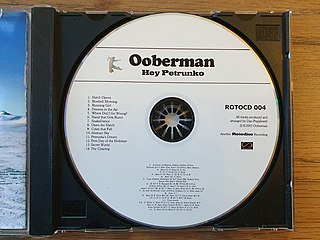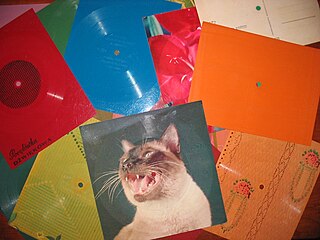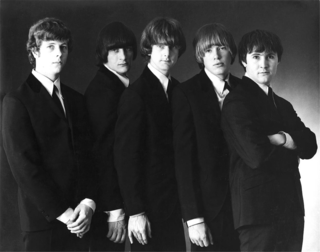
In music, a single is a type of release of a song recording of fewer tracks than an album or LP record, typically one or two tracks. A single can be released for sale to the public in a variety of physical or digital formats. Singles may be standalone tracks or connected to an artist's album, and in the latter case would often have at least one single release before the album itself, called lead singles.

A phonograph record or a vinyl record is an analog sound storage medium in the form of a flat disc with an inscribed, modulated spiral groove. The groove usually starts near the outside edge and ends near the center of the disc. The stored sound information is made audible by playing the record on a phonograph.

Worldwide, the British rock band the Beatles released 12 studio albums, 5 live albums, 51 compilation albums, 36 extended plays (EPs), and 17 box sets. In their native United Kingdom, during their active existence as a band, they released 12 studio albums, 1 compilation album, and 13 EPs. The early albums released from 1962 to March 1968 were originally on Parlophone, and their albums from August 1968 to 1970 were on their subsidiary label Apple. Their output also includes vault items, remixed mash-ups and anniversary box-sets.

The twelve-inch single is a type of vinyl gramophone record that has wider groove spacing and shorter playing time with a "single" or a few related sound tracks on each surface, compared to LPs which have several songs on each side. It is named for its 12-inch (300 mm) diameter that was intended for LPs. This technical adaptation allows for louder levels to be cut on the disc by the mastering engineer, which in turn gives a wider dynamic range, and thus better sound quality. This record type, which is claimed to have been accidentally discovered by Tom Moulton, is commonly used in disco and dance music genres, where DJs use them to play in clubs. They are played at either 33+1⁄3 or 45 rpm. The conventional 7-inch single usually holds three or four minutes of music at full volume. The 12-inch LP sacrifices volume for extended playing time.

A double album is an audio album that spans two units of the primary medium in which it is sold, typically either records or compact disc. A double album is usually, though not always, released as such because the recording is longer than the capacity of the medium. Recording artists often think of double albums as being a single piece artistically; however, there are exceptions, such as John Lennon's Some Time in New York City and OutKast's Speakerboxxx/The Love Below . Since the advent of the compact disc, albums are sometimes released with a bonus disc featuring additional material as a supplement to the main album, with live tracks, studio out-takes, cut songs, or older unreleased material. One innovation was the inclusion of a DVD of related material with a compact disc, such as video related to the album or DVD-Audio versions of the same recordings. Some such discs were also released on a two-sided format called DualDisc.

An album is a collection of audio recordings issued on a medium such as compact disc (CD), vinyl (record), audio tape, or digital. Albums of recorded sound were developed in the early 20th century as individual 78 rpm records (78s) collected in a bound book resembling a photo album; this format evolved after 1948 into single vinyl long-playing (LP) records played at 33+1⁄3 rpm.

The overwhelming majority of records manufactured have been of certain sizes, playback speeds, and appearance. However, since the commercial adoption of the gramophone record, a wide variety of records have also been produced that do not fall into these categories, and they have served a variety of purposes.

A CD single is a music single in the form of a compact disc (CD). Originally the CD single standard was an 8 cm (3-inch) "mini CD" (CD3); later on the term referred to any single recorded onto a CD of any size, particularly the 12 cm (5-inch) "full-size" disc (CD5). From a technical viewpoint, a CD single is identical to any other audio CD. The format started gaining popularity in the early 1990s, but quickly declined in the early and mid 2000s, in favor of digital downloaded singles and CD albums.

The Voice of Frank Sinatra is the debut studio album by American singer Frank Sinatra, released on Columbia Records, catalogue C-112, March 4, 1946. It was first issued as a set of four 78 rpm records totaling eight songs, the individual discs given Columbia 78 catalog numbers 36918, 36919, 36920, and 36921. The album went to number 1 on the fledgling Billboard chart. It stayed at the top for seven weeks in 1946, spending a total of eighteen weeks on the charts. The album chart consisted of just a Top Five until August 1948. The cover depicted is that of the original 78 rpm release cover, also used on the compact disc reissue.

Something Else from The Move is a five-track live EP by the English pop band the Move, released on 21 June 1968 through Regal Zonophone. The Move established themselves with a series of singles that reached the top-five in the UK singles chart, generating hype for an album. After rumours about a live LP began circulating, the Move's manager Tony Secunda pitched an idea about recording an EP of live performances at the Marquee Club in central London. The recordings were taped by producer Denny Cordell at two separate performances in February and May 1968. Technical difficulties forced the band to re-record certain aspects of their performance.

The LP is an analog sound storage medium, specifically a phonograph record format characterized by: a speed of 33+1⁄3 rpm; a 12- or 10-inch diameter; use of the "microgroove" groove specification; and a vinyl composition disk. Introduced by Columbia Records in 1948, it was soon adopted as a new standard by the entire US record industry and, apart from a few relatively minor refinements and the important later addition of stereophonic sound in 1957, it remained the standard format for record albums during a period in popular music known as the album era. LP was originally a trademark of Columbia and competed against the smaller 7-inch sized "45" or "single" format by RCA Victor, eventually ending up on top. Today in the vinyl revival era, a large majority of records are based on the LP format and hence the LP name continues to be in use today to refer to new records.

Merry Christmas is a Christmas-themed compilation album by Bing Crosby that was released in 1945 on Decca Records. It has remained in print through the vinyl, CD, and downloadable file eras, currently as the disc and digital album White Christmas on MCA Records, a part of the Universal Music Group, and currently on vinyl as Merry Christmas on Geffen Records. It includes Crosby's signature song "White Christmas", the best-selling single of all time with estimated sales of over 50 million copies worldwide. The album was certified 4× Platinum by RIAA for selling over 4 million copies in United States. The original 1945 release and subsequent re-releases and re-packages spent a total of 39 weeks at no. 1 on the Billboard pop albums chart.
BOB were an indie pop band from North London, England, formed in 1986.

The Byrds were an American rock band formed in Los Angeles, California in 1964. The bulk of the band's releases were issued on Columbia Records or its subsidiaries, except their final studio album, Byrds, and its associated singles, which Asylum Records released in 1973. Before signing a recording contract with Columbia, the band released a single with Elektra Records in 1964 under the name the Beefeaters.
A mini-LP or mini-album is a short record album or LP, usually retailing at a lower price than an album that would be considered full-length. It is distinct from an EP due to containing more tracks and a slightly longer running length. A mini-LP is not to be confused with the Japanese CDs issued in a "mini LP sleeve" or "paper jacket". In South Korea, a mini album (Korean: 미니앨범) is a type of music release that contains 4-7 songs.

Family Fodder is an English post-punk group revolving around songwriter, multi-instrumentalist, composer/producer, and guitarist/keyboard player Alig Fodder. Formed in London in the 1970s, it has had a sporadic existence ever since, disbanding in the 1980s then reforming. NME described their song "Dinosaur Sex" as a "forgotten post-punk classic".

In their native Great Britain, between 1963 and 2019, the English rock band The Searchers released 8 studio albums, 9 extended plays (EPs) and 30 singles. However, the band's international discography is complicated, due to different versions of their albums sometimes being released in other countries, particularly in the US. In some cases, the US version would be an entirely different album with different cover photos and tracks.

That Bad Eartha is a twelve-song reconfiguration of material from American singer Eartha Kitt's first two eight-song, 10-inch albums issued by RCA Victor. It contains all eight songs from the 1953 album RCA Victor Presents Eartha Kitt. It repurposes the cover image and title, and four of the songs from Eartha's 1954 second 10-inch album, That Bad Eartha . In this way, it could be considered an expansion of the first short-length album, supplementing it with packaging and selected songs from the second.

The Immortal Charlie Parker is an LP record by Charlie Parker, released posthumously by Savoy Records. Several tracks on this album had been previously released on other formats, but is the first 12-inch release of these master takes. It contains selections from five sessions recorded between 1944 and 1948, and contains several previously unreleased alternate takes from these sessions.



















